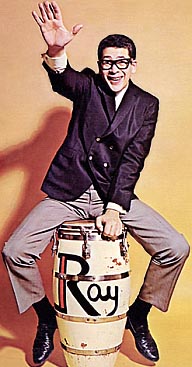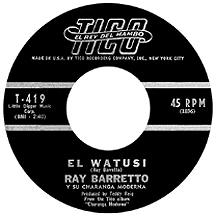RAY BARRETTO
El Watusi
Ray Barretto would one day realize that the first 34 years of his life had been leading up to the moment when two guys would get into a heated argument about a seven-foot man who might be handsome, or might be ugly, but either way everyone runs when they see him. And Ray would supply a Latin music score to this nonsensical Spanish debate and popular radio stations would play the two minute and 40 second musical difference-of-opinion again and again for an audience that, for the most part, didn't understand a word of what was being said. And it would be a great record, the thing he would be most noted for. Sound far-fetched? It's not. It's "El Watusi."
Barretto's parents moved from Puerto Rico to Spanish Harlem in New York City before his birth in 1929, and growing up he was a fan of the hot jazz acts of the '30s. By the time he was 20, with a post-World War II Army stint already behind him, he established himself as a conga player in clubs around the city, eventually performing in the bands of Charlie Parker, Tito Puente and other top stars. In the late '50s he began doing session work, finding himself at the top of everyone's list whenever a conga player was needed. He recorded on albums by R&B saxophonist Eddie "Lockjaw" Davis and legendary flutist Herbie Mann and was solidly established when La Pachanga (first popular in Cuba) became a hot knee-bending, leg-kicking Latin dance and musical style in the early 1960s. Pachanga With Barretto on the Riverside label, a 1961 album of songs written by Puerto Rican pianist Hector Rivera, established Ray as a formidable jazz percussionist.
Then came the formation of his Charanga Moderna (modern band) and the album of the same name on Tico Records, featuring what ultimately became the infamous "El Watusi." It was released after a couple of big "Watusi" hits, yet wasn't about the popular single-person dance...unless having a beat similar to those earlier singles by The Vibrations ("The Watusi") and The Orlons ("The Wah-Watusi") qualifies the song, in which case, yeah, it was about the dance. Actually it was more in reference to the legendarily large-in-stature Watusi tribesmen of Rwanda, a point made obvious with its "I'm the tallest man" banter. Barretto (also the song's writer) had found an outlandish but happy medium between the popular dance and the image of the towering African warriors.

In April 1963 the song was a top hit in New York and had its best showing in Los Angeles, rising to number one by the end of the month. It was all over L.A.'s airwaves that spring and made a surprise showing in a number of U.S. cities, yet in many areas it wasn't played at all, either due to the Spanish language barrier or that it just didn't fit the demographic of certain markets. Once all the regional differences were taken into account, "El Watusi" turned out to be a pretty big hit, making it to number 17 nationally.
Now, if you had made a bet with someone that a seemingly niche artist like this would never have another hit in the mainstream pop market, you would most likely be correct. For one, Barretto's follow-up was little more than "El Watusi Part Two." Titled "Mr. Blah Blah," it featured a shrill vocal group repetitiously singing the final line of the previous recording with continued arguing from the two caballeros. No surprise that it was universally ignored. But no matter; one hit was all it took. Ray had made his mark as a top Latin bandleader and the conga player of the era. Some three dozen albums followed over the next three decades for several labels, most notably Fania Records, for which his recordings nabbed him six Grammy nominations in the '70s and '80s. Ray also played on sessions for Dizzy Gillsepie (a favorite of his youth and major influence on his career), Cannonball Adderley, Wes Montgomery, Kenny Burrell and many others.
Back to that bet...turns out it wasn't the sure thing you'd figured on, although you wouldn't have had to pay up until the 1990s. First, Barretto reappeared in the top 40 as a writer, with "Deeper Shade of Soul" by Urban Dance Squad in '91 (a remake of his original from the 1968 Fania album Acid). Then in 1997 he was back again, this time as a member of The Blackout Allstars, which included longtime contemporary Tito Puente, Grover Washington, Jr. and female percussion counterpart Sheila E; "I Like It" (a remake of Pete Rodriguez's 1967 Latin boogaloo party song "I Like it Like That") sent him into the top 40 for a third time (second as a performer) as a result of its exposure in a Burger King commercial. Three big pop hits for conga master Ray Barretto! Don't bet against him!


